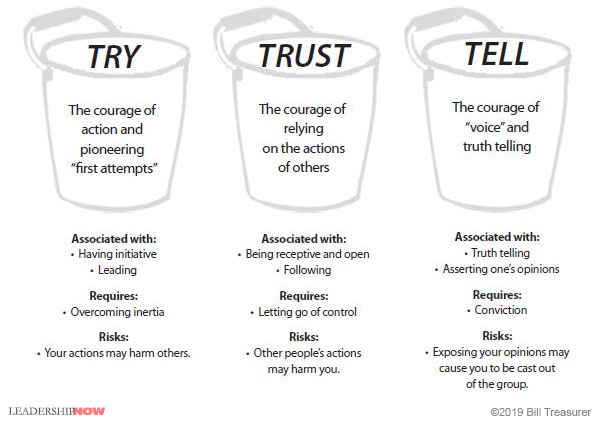A strength we often envy in others is confidence – the belief that whatever the situation throws at us, we’ll be able to handle it. But there's another quality that will probably affect your career trajectory and personal brand even more: your willingness to act courageously.
When thinking about courage, we mostly equate it with the kind of personal bravery that pushes women to demonstrate for basic rights in the streets of Shiraz or those who run into a burning building to save their neighbour’s Chihuahua. These are extreme examples of ordinary people doing extraordinary things which, luckily, most of us can’t relate to.
We don’t always acknowledge more pedestrian forms of courage, especially at work. The stakes may be lower, but there are plenty of situations where practising courage in a more corporate setting carries significant risks – whether that’s reputational, financial, emotional and – in some cases – even physical.
However, if done timely and cautiously, taking bold professional action will dramatically and positively impact your career and business prospects.
A natural bias against taking risks
Before offering suggestions on how to get better at it, let’s define courage first.
At its most basic, courage is the willingness to act despite your fear. Fear therefore relates to courage in the same discomfort relates to discipline – one can’t exist without the other. Without the trepidation of taking a risk, there can be no courage. A soldier with zero concern about stepping into the battlefield is not courageous – they’re a psycho. Likewise, an account executive who publicly berates their company CEO without any misgiving isn’t audacious but merely arrogant.
Your ability to act courageously at work therefore strongly correlates with your willingness to take professional risks, as well as your desire to step into discomfort. In the words of author Mark Manson:
“Fear doesn’t control us by dominating our emotions. It controls us by quietly convincing us that our comfort is more important than happiness. The only real risk is taking no risks. The only real failure is having no failures. The only real pain is the avoidance of pain.”
Without taking risks, there can be neither growth nor innovation. Yet, most of us hold deeply ingrained negative beliefs towards risk that prevent us from forging ahead even when we know that would be the smart thing to do. We're so wired to resist the unknown that we've become bad at tolerating any kind of ambiguity.
But risk-taking is not the same as acting recklessly or irresponsibly. The smart way to take risks is to weigh up the potential consequences of each action and then execute with well-thought-out decisions – despite your fears.
In the words of philosopher Simone Weil: "Risk is an essential need of the soul. The absence of risk produces a kind of boredom which paralyses in a different way from fear, but almost as much."
Why some are more courageous than others
There’s no shame in feeling fear. Being afraid simply means your biological wiring is doing what it’s meant to do – protecting you from maybe harming yourself.
When it comes to courage, it’s not the level of fear that matters but your resilience towards it. In other words, to be courageous, your willingness to act always has to be greater than the fear itself. Author Robert Biswas-Diener calls this division the courage quotient.
Of course, fear levels are highly subjective, and your courage quotient will depend on several factors.
Some people are labelled as ‘Type T’ personalities, whose brain structures cause them to seek more thrill-seeking activities. They have fewer dopamine receptors to record pleasure or satisfaction, so they naturally require higher levels of stimulation and endorphin activity to feel good. This makes them more likely to act more courageously – and recklessly.
Non-biological factors play a role too. Suppose you were lucky enough to grow up around people who encouraged you to be courageous. You also have a clear value system and solid opinions you want to share with the world. In that case, you’re more likely to act bravely, even if your genes predispose you towards faintheartedness.
Personality matters too. Studies established a clear link between courage and character traits such as openness to new experiences, self-efficacy (hence the link with confidence), high self-esteem, and having a decent ability to regulate one’s anxiety levels.
Lastly, your environment is important too. It’s easier to do the courageous thing when you think your peer group will likely agree, but much harder when you know your views aren’t going to be shared by those who matter. In case of the latter, we're much more likely to succumb to peer pressure and group think, or deferring to whoever’s in charge.
Types of courage in the workplace
Author and leadership Coach Bill Treasurer distinguishes between three types of courage we can practise more at work: TRY, TRUST and TELL courage.

TRY courage
TRY courage requires action, which makes it particularly relevant for business leaders and entrepreneurs. It relates to any activity that involves risk, is done for the first time, or takes you beyond your comfort zone. For example, starting a new initiative, entering a workstream you’re unfamiliar with, or taking on new responsibilities.
TRY courage forces you to ‘step up to the plate’. It pushes you past the natural inertia you feel whenever asked to do something that can lead to failure. But while the risk of negative fall-out for your personal brand, team members, or organisation may be high, so are often the potential rewards.
TRUST courage
Unlike TRY courage, TRUST courage requires inaction. It demands that you resist the temptation to control others and let go of decision-making by delegating.
TRUST courage means stepping back and letting go; something micromanagers find very difficult because they’re afraid others won’t step up to the plate. They fear that trusting someone else will come back to bite them in the backside. TRUST courage therefore involves allowing colleagues to take the lead, which can feel like a big ask when you’ve been burned in the past. But hard as it may be, TRUST courage is vital for fostering collaboration and stopping yourself from getting overwhelmed.
TELL courage
TELL courage is the easiest to picture in a work context. Like TRY courage, it’s an active form of courage because it requires you to take a stand and speak your truth, no matter how uncomfortable it feels to you and the receiver.
TELL courage could involve offering difficult feedback or calling out inappropriate or unethical behaviour. But it could also take the form of admitting you’ve made a mistake. TELL courage forces you to be assertive. You state your needs and then negotiate a way forward. People pleasers find this type of courage particularly uncomfortable. Their prime fear of being cast out by the group can be so intense that they’d often rather bite their tongue than rock the boat.
Why courage helps career progression
Along with confidence and gravitas, courage is one of a Holy Trinity of leadership traits.
Speaking up and acting on your beliefs – no matter how unconventional or risky – allows you to showcase professional flair and innovative thinking. People notice your confidence and your willingness to lead from the front. Done well, you’ll earn the respect of your peers and forge strong relationships, thus increasing your chances for advancement.
But while taking risks at work often pays off, let’s not be naive. Bad things do happen to those who challenge the status quo, and not every risk will go in your favour. If nobody ever suffered the consequences of a particular decision by getting fired or having their reputation shattered, the word courage wouldn't even have been invented.
If courage is something you're struggling with, here are a few easy ground rules you can stick to.
1) Tackle your courage blindness
Most of us have a distorted view of our personal courage quotient. Unless you suffer from grandiosity, you probably think you’re way less courageous than past evidence would suggest. To get a more realistic perspective on how brave you are, you need to tackle any courage blindness. Do an inventory of all the moments in your life when you stepped up to the plate despite being scared of failing or looking like a numpty. Put together a courage ‘brag folder’ and use it as your personal highlight reel and a reminder of all the moments you decided to push ahead despite your fears.
2) Earn goodwill credits
In his book Choosing Courage, author James R Detert states it's those employees who invested a long time in performing well and being loyal to the organisation for whom workplace courage often produces the best results.
Their previous conformity and work history have earned them enough 'goodwill credits' to gain the trust of their superiors. The more of these credits you earn, the more likely you’ll be able to trade them in successfully whenever you feel those in power need to be challenged.
3) Pick your battles
Before picking a fight at work, ask yourself two questions: Is this really important? And is this the right time?
To answer both questions, you'll need to pit your personal values, ethics and goals against those of your colleagues, the organisation and/or wider stakeholders. Try and be dispassionate when answering them. Let your emotions inform your decision to pick a battle, but don’t be held hostage by them. Perhaps, there's a bigger war you’re fighting and picking this particular battle may make it less likely you'll win that war.
4) Pick your timing
Competently courageous people are often masterful planners. They don’t waste their goodwill credits on whimsical requests, instead waiting patiently for the right moment.
They keep an eye out for trends and events that are happening around them and are often finely tuned into attention cycles and public sentiment, using them to their advantage. They've also developed an accurate sense of timing that allows them to sense when an issue is gaining traction and when their courageous actions are more likely to be well-received.
5) Manage your message and your emotions
Having chosen the right battle and timing to act courageously, it now boils down to communicating your ideas as best as possible while managing the emotions in the room. You do that by framing your proposal so your audience can relate to it, ideally by connecting it to the organisation's priorities or values.
Keep your cool and don’t get drawn into emotional reactions, even if the discussion becomes heated. Simply acknowledge where others are at and stay focused on making data-driven arguments.
6) Recognise your negativity bias
Negativity bias is a well-known phenomenon in psychology. It refers to our tendency to pay more attention to potentially negative outcomes than to positive ones. This built-in pessimism can be a huge block to being more audacious professionally.
When deciding whether to take a particular risk at work, pay equal attention to both the potential positive and negative outcomes. This will help you make a more balanced and accurate judgment. Also reframe any potentially undesirable outcomes in a more constructive way, seeing them as possible opportunities for growth and learning rather than as merely threats (see below).
7) Practise fear setting
The only thing stopping us from doing the courageous thing is the fear of what might happen to us when we do – getting rejected, being out of our depth, or looking silly.
Author and podcaster Tim Ferris developed a helpful fear-setting exercise to help you see more clearly when fear is holding you back. It’s based on the Stoic principle of Premeditatio Malorum, which I wrote about previously. Fear setting forces you to plan ahead in case the worst-case scenario does happen, so you can already start mitigating against it in the present. Here’s a great summary of how to use this exercise.
8) Build a courage ladder
Building a so-called personal courage ladder can be helpful when you're trying to get better at approaching situations that require courage. This technique consists of starting with smaller, more manageable acts of courage and then gradually building up your bravery brag folder over time.
Smaller acts may include challenging your boss about a particular policy, telling your desk neighbour they need to blow their effing nose, or telling Helen from Finance to stop badgering you about those missing expense receipts. Everyone’s courage ladder is unique, however, and in the words of Jim Detert: “If you want to change your behaviour, the only “wrong” ladder is one that you are not willing to climb.
Conclusion: courageous competence pays
The late US senator and onetime prisoner of war, John McCain, once defined courage as: ‘That rare moment of unity between conscience, fear, and action, when something deep within us strikes the flint of love, of honour, of duty, to make the spark that fires our resolve’.
A poetic definition but also a rather lofty one because even some of the most basic tasks you performed today, like reading this sentence, walking to your desk, or using the potty, required courage to perform at one point in your life. They would have taken you right to the edge of your comfort zone
Without courage, you literally get nowhere. You stagnate. The aim is not to become fearless at work; it's to increase your ability to overcome that fear. Finding moments to practise daily bravery will slowly increase your resilience towards uncertainty and allow you to build that courage ladder higher and higher.
[Copyright Ownership: All content and intellectual property, including but not limited to text, images, graphics, logos, audio, and video, made available on krisverle.com or other platforms are protected by copyright laws and owned by the Owner unless otherwise stated.]

